5:The basic components of computer system
6:ARMTM
7:DSP Processor Fundamentals
8:VLSI Architectures
Technical English for Electronic and Information
Engineering
PART 2 — Modern Electronics Devices
Liu Tong
liutong2@mail2.sysu.edu.cn
Huizhou University Department of Electronics Engineering
2017, March
�
5:The basic components of computer system
6:ARMTM
7:DSP Processor Fundamentals
8:VLSI Architectures
Main Content
1 5:The basic components of computer system
2 6:ARMTM
3 7:DSP Processor Fundamentals
4 8:VLSI Architectures
�
5:The basic components of computer system
6:ARMTM
7:DSP Processor Fundamentals
8:VLSI Architectures
Unit 5: The basic components
of computer system
�
5:The basic components of computer system
6:ARMTM
7:DSP Processor Fundamentals
8:VLSI Architectures
New Words and Technical Terms
New Words
memory
bus
processor
semiconductor
performance
location
signal
instruction
flip-flop
chip
transistor
binary
Technical Terms
central processing unit (CPU)
integrated circuit (IC)
input/output (I/O)
metal-oxide semiconductor (MOS)
read random memory (RAM)
only read memory (ROM)
�
5:The basic components of computer system
6:ARMTM
7:DSP Processor Fundamentals
8:VLSI Architectures
Text
Text(1)
The basic components that make up a computer system include: the
CPU, memory, I/O, and the bus that connects these components together.
John Von Neumann, a pioneer in computer design, gave the architec-
ture of most computers in use today. A typical Von Neumann system has
three major parts: the central processing unit (or CPU), memory, and in-
put/output (or I/O). How a system designs these parts impacts the system
performance. In VNA machines, like the 80x86 family, the CPU is
where all the actions take place[1]. All computations occur inside the
CPU. Data and CPU instructions reside in memory until required by the
CPU. To the CPU, most I/O devices look like memory because the CPU
can store data to an output device and read data from an input device.
The major difference between memory and I/O device is that I/O device
is generally associated with external device in the outside world.
�
5:The basic components of computer system
6:ARMTM
7:DSP Processor Fundamentals
8:VLSI Architectures
Text
Text(1)
In VNA machines, like the 80x86 family, the CPU is where
all the actions take place[1].
[1]3VNA¯NX¥§X8086X§CPU·1⁄kfl
/"
3the CPU is where all the actions take place¥§·the
CPU§where all the actions take place·’XBcwherel
Ø¿L.
�
5:The basic components of computer system
6:ARMTM
7:DSP Processor Fundamentals
8:VLSI Architectures
Text
Text(2)
The system bus connects various components of a VNA ma-
chine. The 80x86 family has three major busses: the address bus,
the data bus, and the control bus. A bus is a connection of wires on
which electrical signals pass through components in the system. For
example, the data bus may have a different implementation between
the 80386 and the 8086, but both carry data among the processor,
I/O, and memory. The 80x86 processor uses the data bus to trans-
fer data among the various components in a computer system. The
size of this bus varies widely in the 80x86 family.
Indeed, this bus
defines the /size0of the processor.
�
5:The basic components of computer system
6:ARMTM
7:DSP Processor Fundamentals
8:VLSI Architectures
Text
Text(3)
The data bus on an 80x86 family processor transfers information
between a particular memory location or I/O device and the CPU.
The only question is, /Which memory location or I/O device?0The
address bus answers this question.
�
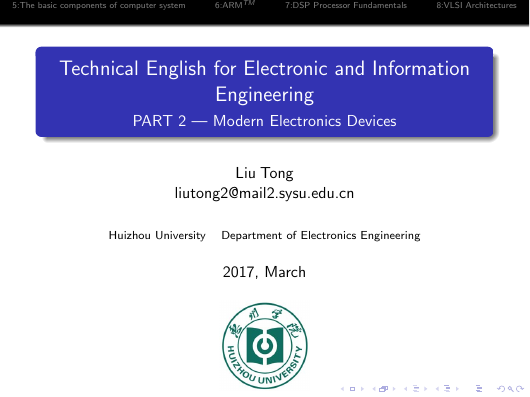


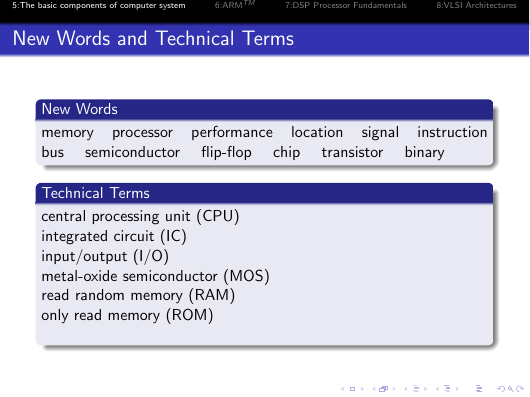
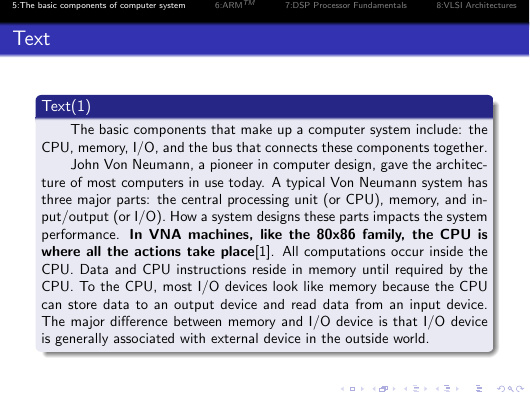
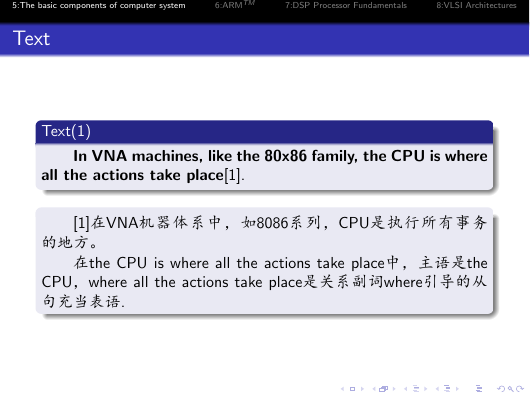

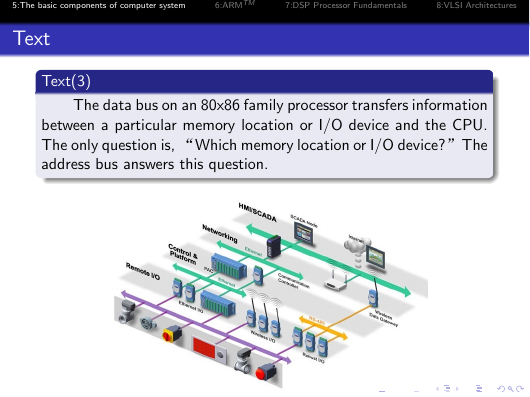








 2023年江西萍乡中考道德与法治真题及答案.doc
2023年江西萍乡中考道德与法治真题及答案.doc 2012年重庆南川中考生物真题及答案.doc
2012年重庆南川中考生物真题及答案.doc 2013年江西师范大学地理学综合及文艺理论基础考研真题.doc
2013年江西师范大学地理学综合及文艺理论基础考研真题.doc 2020年四川甘孜小升初语文真题及答案I卷.doc
2020年四川甘孜小升初语文真题及答案I卷.doc 2020年注册岩土工程师专业基础考试真题及答案.doc
2020年注册岩土工程师专业基础考试真题及答案.doc 2023-2024学年福建省厦门市九年级上学期数学月考试题及答案.doc
2023-2024学年福建省厦门市九年级上学期数学月考试题及答案.doc 2021-2022学年辽宁省沈阳市大东区九年级上学期语文期末试题及答案.doc
2021-2022学年辽宁省沈阳市大东区九年级上学期语文期末试题及答案.doc 2022-2023学年北京东城区初三第一学期物理期末试卷及答案.doc
2022-2023学年北京东城区初三第一学期物理期末试卷及答案.doc 2018上半年江西教师资格初中地理学科知识与教学能力真题及答案.doc
2018上半年江西教师资格初中地理学科知识与教学能力真题及答案.doc 2012年河北国家公务员申论考试真题及答案-省级.doc
2012年河北国家公务员申论考试真题及答案-省级.doc 2020-2021学年江苏省扬州市江都区邵樊片九年级上学期数学第一次质量检测试题及答案.doc
2020-2021学年江苏省扬州市江都区邵樊片九年级上学期数学第一次质量检测试题及答案.doc 2022下半年黑龙江教师资格证中学综合素质真题及答案.doc
2022下半年黑龙江教师资格证中学综合素质真题及答案.doc